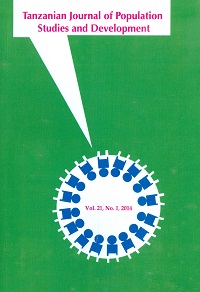Analysis of Agriculture versus Industry-led Development And their Impacts on Growth and Poverty in Tanzania
Abstract
The government has created several economic plans and institutions to boost agriculture so that it can play its rightful role as the engine of national economic growth. The sector unexpectedly failed to deliver because the attempts did not solve adequately the fundamental problems besetting the sector, namely backward technology and poor management of the set-up institutions. Given the poor performance of agriculture in the past, can it still play a leading role in economic growth once policy makers address the fundamental problems it faces now? The purpose of this paper is to examine empirically the potentialities of the sector in economic development. The paper adopts a Social Accounting Matrix framework to check whether the traditional key role of agriculture in economic development is still relevant. The evaluation of the ascendancy of agriculture over industry relies on the contribution of demand shocks on different sectors to economic growth, alleviation of poverty and equity in Tanzania. Evidence shows that financial support directed at promoting the agricultural sector and agriculture-based processing activities relative to other activities induces the highest economic growth in Tanzania. It also raises the incomes of unskilled agricultural workers, and particularly unskilled female labour. The rural and urban poor families also gain more from the modernisation of the agricultural sector. The results of the analysis lead us to believe that agricultural development strategy yields better-targeted outcomes than industrialization-centred development. Export promotion of agricultural products leads relatively to higher economic growth, greater poverty alleviation, and better equity than emphasis on industrialisation.
References
Adelman, I., & S. Robinson. 1986. US Agriculture in a General Equilibrium Framework: An Analysis with a Social Accounting Matrices. American Journal of Agricultural Economics, Vol. 68, No. 5: 1196-1207.
Banda, T. 1997. Some Critical Preconditions for Agricultural Take-Off in Tanzania. In D. Bol, N. Luvanga, & J. Shitundu (eds). Economic Management in Tanzania. Dar es Salaam: TEMA Publishers Company Ltd.
Cohen, S.I. 1989. Multiplier Analyses in Social Accounting and Input-Output Frameworks: Evidence for Several Countries. In R. Miller, K.P. Polenske, & A. Rose. Frontiers of Input-Output Analysis. Oxford, Oxford University Press.
D ' Antonio, M., R. Colaizzo, & G. Leonello. 1988. Mezzogiorno/Centre-North: A Two-Region Model for the Italian Economy. Journal of Policy Modeling, Vol. 10 No. 3, pp. 437-451.
Esparza, A. 1989. Defense Impact Analysis Within Social Accounting Matrix. Growth and Change, Vol. 20, No. 3: 63-79.
Hazell, P.B.R., C. Ramasamy, & V. Rajagopalan. 1991. An Analysis of the Indirect Effects of Agricultural Growth on the Regional Economy. In P.B.
Hazell, and R.C. Ramasamy (eds). The Green Revolution Reconsidered: The Impact of High-Yielding Rice Varieties in South India. Baltimore: Johns Hopkins University Press.
Holland, D., & P. Wyeth. 1993. SAM Multipliers: Their Interpretation and Relationship to Input-Output Multipliers. Research Bull. XB1027, College of Agriculture and Home Economics Research Center, Washington State University, Pullman.
Keuning, S., & E. Thorbecke. 1989. The Impact of Budget Retrenchment on Income Distribution in Indonesia: A Social Accounting Matrix application. OECD Working Paper, No. 3, Development Centre, Paris.
Lewis, B.D., & E. Thorbecke. 1992. District-Level Economic Linkages in Kenya: Evidence Based on a Small Regional Social Accounting Matrix. World Development, Vol. 20, No. 6: 881-897.
Morrissey, O., & V. Leyaro. 2007. Distortions to Agriculture Incentives in Tanzania: Credit, University of Nottingham Working Paper 52. Available at: http://ideas.repec.org/ p/ags/wbadwp/48550.html.
Naho, A.M. 2008. Macroeconomic Adjustments, Income Distribution and Poverty in Tanzania: an Empirical Investigation of Alternative Demand Shocks and Domestic Policy Changes Using SAM/CGE Approaches. PhD Thesis, University of Dar es Salaam, Tanzania.
Parikh, A., & E. Thorbecke. 1996. Impact of Rural Industrialization on Village Life and Economy: A SAM Approach. Economic Development and Cultural Change, Vol. 44, No.2: 351-377.
Pyatt, G. 1988. A SAM Approach to Modeling. Journal of Policy Modeling, Vol. 10 No. 3: 327-352.
Pyatt, G., & J.I. Round. 1979. Accounting and Fixed Price Multipliers in Social Accounting Framework. Economic Journal, Vol. 89, No. 356: 850-873.
Reinert, K.A, & D.W. Roland-Holst. 1997. Social Accounting Matrices. In J.F.
Francois, & K.A. Reinert. Applied Methods for Trade Policy Analysis: A Handbook. Cambridge: Cambridge University Press.
Robinson, S. 1989. Multisector Models. In H. Chenery, & T.N. Srinivasan. Handbook of Development Economics, Vol. 2, North Holland, Elsevier Science Publishers.
Sadoulet, E., & A. de Janvry. 1995. Quantitative Development Policy Analysis, Baltimore and London: The Johns Hopkins University Press.
Subramanian, S., & E. Sadoulet. 1990. The Transmission of Production Fluctuations and Technical Change in a Village Economy. Economic Development and Cultural Change, Vol.39, No. 1: 131-173.
Thurlow, J., & P. Wobst. 2003. Poverty-focused Social Accounting Matrices for Tanzania. International Food Policy Research Institute. Trade and macroeconomics Division Discussion Paper 112. Available at: http://www.ifpri.org/divs/tmd/dp/papers/ tmdp112.
United Republic of Tanzania, Vice President ' s Office. 2005. National Strategy for Growth and Reduction of Poverty (NSGRP). Available at: http://www.tanzania.go.tz/nsgrf.html
United Republic of Tanzania, Ministry of Finance and Economic Affairs. 2010. National Strategy for Growth and Reduction of Poverty II (NSGRP II). Available at: http://www.mof.go.tz/


